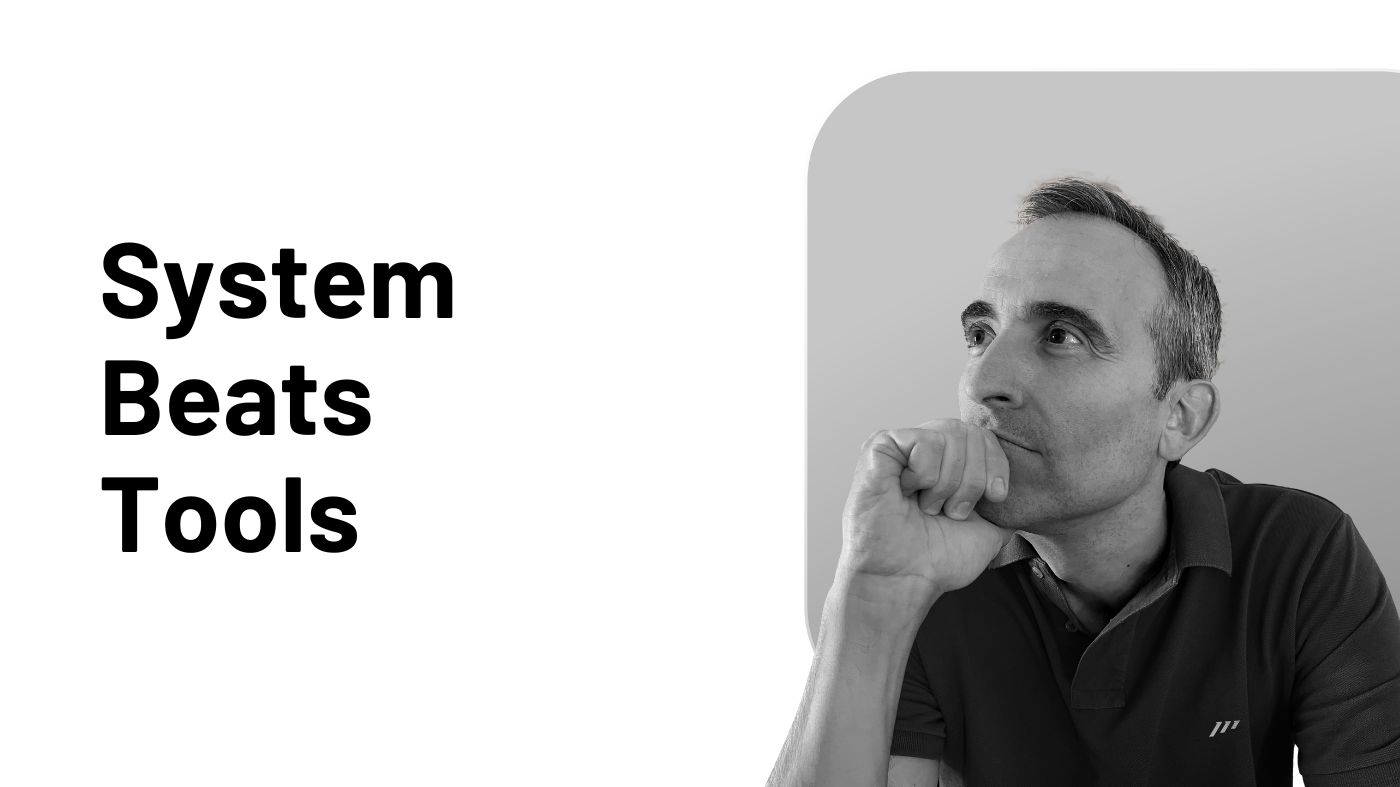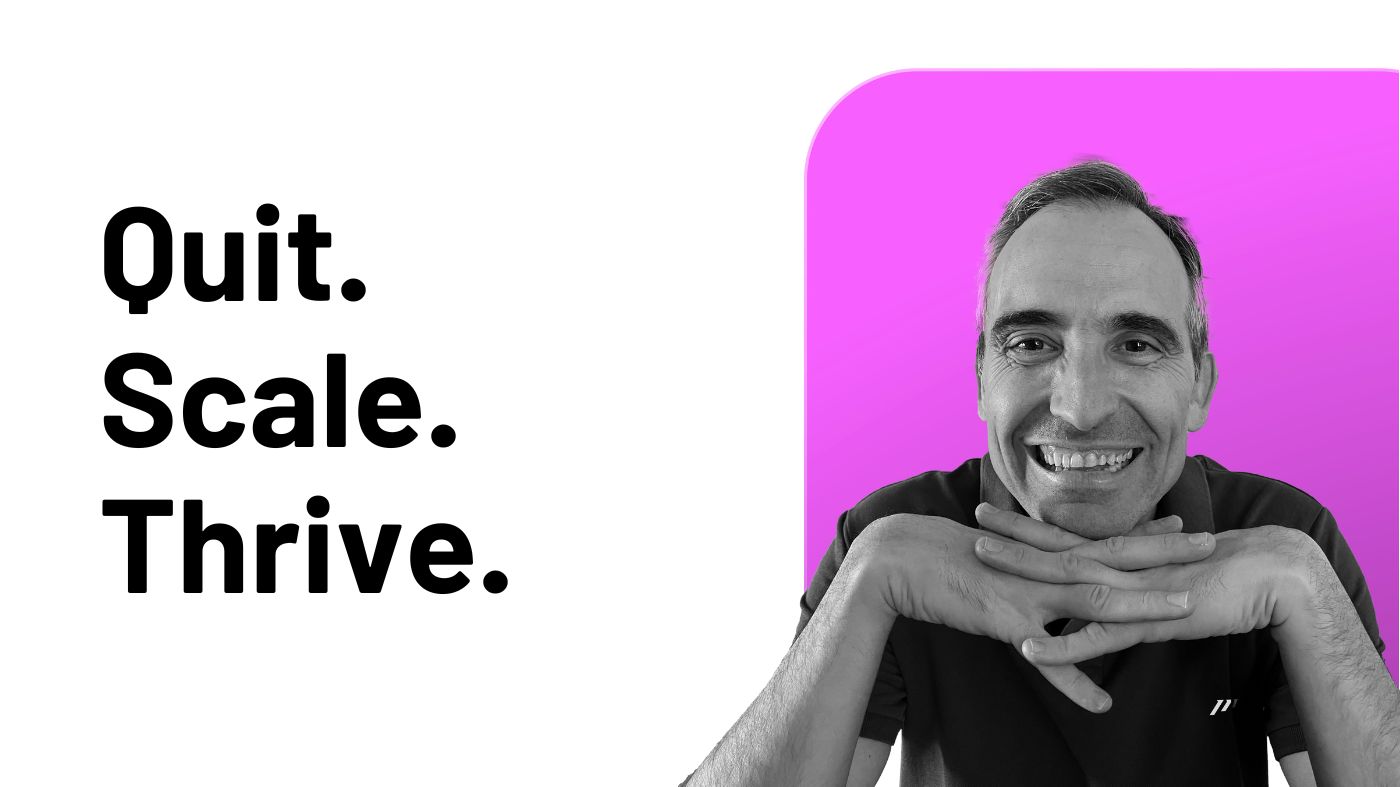“This is the most important tool in my productivity stack!”
I’ve heard this statement countless times, from startup founders, executives, and even self-proclaimed productivity gurus. Each time, I can’t help but cringe.
Why?
Because this single sentence reveals a fundamental misunderstanding of how true productivity works at scale.
After decades in the productivity trenches, I’ve specialized in helping busy professionals and businesses thrive through process optimization and implementing productivity systems that actually work. Not theoretical frameworks, but practical solutions for the real scenarios executives, entrepreneurs, and managers face daily.
When someone points to their favorite tool as their productivity cornerstone, they’re unknowingly admitting they lack a system. It’s like a surgeon declaring the scalpel is more important than sterilization: a dangerous oversimplification.
In this article, I’ll show you why the “most important tool” mindset is not just wrong: it’s fundamentally at odds with established systems theory principles. More critically, it’s actively preventing you from reaching your full potential.
I’ll reveal the system-thinking approach that has allowed countless busy professionals to transform their productivity without burning out, no matter the volume of information or actions they need to manage on a daily basis with consistency, regardless of their industry or role.
Let’s demolish this productivity myth, “The most important tool”, once and for all!
The Definitive Framework of Productivity Systems
Let me begin with precision: a system, by formal definition, is a set of interconnected elements coherently organized to achieve a specific purpose by converting inputs into outputs through specific processes.
This isn’t just my interpretation, it’s the cornerstone of general systems theory, first developed by biologist Ludwig von Bertalanffy in the 1940s and further refined across disciplines from cybernetics to organizational management.
In his seminal work, “General System Theory: Foundations, Development, Applications,” Bertalanffy established that true systems, whether biological organisms or organizational structures, must be understood as wholes rather than collections of independent parts.
This holistic perspective is precisely what’s missing when professionals fixate on individual productivity tools.
The critical aspects of any true system are:
-
Elements: The identifiable components that make up the system.
-
Interconnections: The relationships between these elements that determine how they influence each other.
-
Purpose: The function or goal the system is designed to achieve.
-
Emergence: The properties and capabilities that arise from the system as a whole but aren’t present in any individual component, what systems theorists call “emergent properties.”
In a properly designed system, each element is necessary but insufficient on its own.
As Peter Senge explained in “The Fifth Discipline,” this creates what he terms “dynamic complexity”, where cause and effect aren’t closely related in time and space, making linear thinking ineffective.
Remove any component, and the system’s functionality degrades or fails entirely.
This fundamental principle applies whether we’re discussing biological organisms, manufacturing processes, or, critically for our discussion, productivity frameworks.
“The righter you do the wrong thing, the wronger you become.” — Russell Ackoff
When I audit a professional’s productivity approach, I look for these systemic properties. Most struggling executives have collections of tools, not systems. The distinction is crucial.
A collection is merely an assortment of tools without deliberate integration. A system transforms these individual tools into something greater through intentional design of their interconnections.
Consider the human body as the quintessential example of a system.
Your circulatory system cannot function without your respiratory system. Your nervous system requires your endocrine system. No single system can be declared “most important” because they form an interdependent whole.
The same applies to your productivity infrastructure.
Your calendar, task manager, note-taking tool, and project management software must function as an integrated system, not competing tools, to support sustained high performance.
I’ve seen this repeatedly in my work with C-suite executives: those who approach productivity systemically consistently outperform those seeking silver-bullet solutions.
The former build resilient productivity architectures; the latter chase temporary fixes that inevitably break under pressure and the reality of their complex lives.
The Illusion of Hierarchy: Why Size Doesn’t Determine Importance
One of the most damaging misconceptions in productivity is that bigger, more complex tools are inherently more valuable than smaller, simpler ones.
This hierarchical thinking leads professionals to overinvest in feature-bloated software while neglecting critical “minor” components of their system.
This misconception directly contradicts what systems theorist Donella Meadows identified as “leverage points”, places in a complex system where small changes can produce significant improvements. In her influential work “Thinking in Systems,” Meadows demonstrated that the most powerful interventions often occur in the smallest, least obvious components.
As humans, we’re biologically wired to equate size with importance.
It’s an evolutionary shortcut that served our ancestors well but fails us in systems thinking.
Cognitive scientists call this the “salience bias”, our tendency to focus on features that are more prominent and ignore those that are less conspicuous but potentially more impactful.
When consulting with executive teams struggling with productivity bottlenecks, I consistently find the problem isn’t with their primary tools but with overlooked smaller components.
“Today’s problems come from yesterday’s ‘solutions.’” — Peter Senge
In a properly designed system, size and complexity have zero correlation with importance.
This principle aligns with what Russell Ackoff, pioneer in systems thinking and organizational theory, termed “synthetic thinking”, understanding that the performance of a system depends on how its parts interact, not on how each performs independently. As Ackoff wrote, “A system is never the sum of its parts; it’s the product of their interactions.”
Let’s consider these examples to provide even more clarity.
The Patek Philippe Grandmaster Chime watch contains over 1,500 components.
Despite the fact that the most expensive version, the unique stainless steel Ref. 6300A-010, fetched $31 million at auction in 2019, becoming the most expensive wristwatch ever sold, a single microscopic spring failure renders the entire masterpiece useless. The watchmakers don’t prioritize components by size but by function within the system.
The executive calendar system I implemented for a CEO included a seemingly trivial five-minute daily review ritual.
When she abandoned this “small” practice during a particularly hectic quarter, her entire scheduling framework collapsed within weeks, despite using the same “important” calendar software.
The orchestra analogy proves particularly instructive.
During a Madrid Philharmonic performance I attended, the triangle player performed fewer than 20 notes in a 90-minute concert. Yet without those precisely timed notes, the entire composition would have been fundamentally altered. The conductor doesn’t consider the triangle player “less important” than the first violinist: both are essential to the intended outcome.
This phenomenon exemplifies what complexity theorist Stuart Kauffman describes as “contingent necessity”, where seemingly minor elements become critically important due to their specific position and timing within a complex system.
Nature reinforces this principle everywhere:
-
A single neurotransmitter imbalance can affect entire neural networks in the brain.
-
A single missing enzyme can disrupt an entire metabolic pathway.
-
The smallest genetic mutation can fundamentally alter an organism.
These natural examples illustrate what systems biologists call “critical dependencies”: relationships where the functioning of the entire system hinges on seemingly minor components performing their specific roles.
When designing productivity systems for high-performance professionals, I apply this exact principle. Your two-minute capture routine might appear insignificant compared to your robust project management software, but remove it, and watch how quickly information begins to leak from your system.
A C-level manager I worked with insisted his project management platform was the “cornerstone” of his productivity. Yet when we mapped his entire workflow, we discovered a simple pocket notebook was actually the critical intake mechanism for his most important insights. Without this “minor” component, his expensive software became a sophisticated repository of second-rate ideas.
This principle has profound implications for your productivity architecture: honor each component based on its function, not its size or perceived status.
Your simplest tool may be the linchpin that holds everything else together.
My Tool System: An Integrated Productivity System
Let me share my personal productivity system to illustrate these principles in action.
Disclaimer: What follows isn’t a recommendation to adopt these specific tools, but rather a demonstration of how thoughtfully integrated components create a productivity system greater than its parts.
This approach embodies what systems engineer John Gall described in his eponymous law: “A complex system that works is invariably found to have evolved from a simple system that worked.”
The productivity system I’m about to describe wasn’t designed in one fell swoop but evolved iteratively through continuous testing and refinement, a process complexity theorists call “adaptive emergence.”
When analyzing my workflow, I identified distinct information types that required specialized handling:
-
Time commitments: Calendar system.
-
Actions and tasks: Task management system.
-
Projects and team coordination: Project management system.
-
Ideas and knowledge: Note-taking and PKM (Personal Knowledge Management) system.
-
Daily structure: Planning system.
-
Communication flow: Messaging system.
This structured categorization follows what information theorist Claude Shannon established as the principle of “minimum entropy”: organizing information in ways that maximize signal and minimize noise. By creating clear boundaries between information types, the system reduces cognitive load and decision fatigue.
Each component manages what it does best:
-
My calendar doesn’t try to be a task manager.
-
My project manager doesn’t attempt to replace my note-taking system.
I’ve designed clear handoffs between these tools, creating an information flow that eliminates friction and prevents items from falling through the cracks.
These handoffs represent what systems engineers call “interface protocols, standardized methods for components to exchange information while maintaining their specialized functions.
“In a network, the components and the processes are not separate — they are two aspects of the same dynamic.” — Fritjof Capra
In complex adaptive systems, well-designed interfaces often determine system resilience more than the individual components themselves.
What’s crucial to understand: if I were forced to remove any single component, the entire productivity system would degrade. There is no hierarchy of importance; only a web of interdependence.
For example, when I experimented with consolidating my notes into my project management tool to “simplify” my system, the quality of my thinking deteriorated noticeably. The specialized interface for thought development was actually critical, not just a luxury.
This illustrates the concept of “requisite variety” from cybernetics pioneer W. Ross Ashby, who established that a system’s internal diversity must match the complexity of its environment to function effectively. By trying to reduce tool variety, I had inadvertently violated this fundamental systems principle.
Similarly, when I tried to manage all communication through a single channel, important messages became buried, and response times suffered. The specialized communication architecture wasn’t redundant: it was essential.
Communication theorist Marshall McLuhan’s insight that “the medium is the message” proves relevant here: different communication channels aren’t just delivery mechanisms but shape the nature of the information they convey. What works for asynchronous updates fails for urgent requests.
This is precisely where most productivity breakdowns occur for busy professionals. In pursuit of “simplification,” they eliminate components they perceive as secondary, not realizing these elements perform crucial functions within their productivity system.
The goal isn’t maximizing components (that creates unnecessary complexity) or minimizing them (that creates dangerous gaps). The goal is optimization: having exactly the right components, each performing its specialized function within an integrated whole.
This balanced approach aligns with what management theorist Russell Ackoff termed “dissolving” problems rather than merely solving them: designing systems where dilemmas and trade-offs transform into complementary elements of a coherent whole.
When we onboard new executive clients in our Inner Circle Program at the Paperless Movement®, we don’t start by implementing new tools.
Instead, we map their current information and action landscape, identify processing requirements, and design a system where each component serves a distinct purpose while connecting seamlessly to others.
This systems approach transforms productivity from a collection of techniques into an architectural framework that supports sustained high performance.
How to Build Your Own Productivity System
Now that you understand why the “most important tool” mindset is fundamentally flawed, how do you move toward a systems approach to productivity?
Here’s a practical framework we’ve developed at the Paperless Movement® after decades of optimizing workflows for high-achieving professionals.
This framework employs a “middle-out” approach, neither purely top-down nor bottom-up, but starting from the middle where actual work happens and expanding outward.
This strategy aligns with systems thinking principles, emphasizing the importance of connections and feedback at all levels.
Such an approach can foster what complexity scientists describe as “emergent coherence,” where organized patterns arise from the dynamic interactions within the system.
Step 1: Conduct an Information Audit
Begin by tracking every type of information that flows through your work life for one week:
-
What commitments do you make?
-
What tasks do you handle?
-
What ideas need capture?
-
What reference materials do you consult?
-
What communications do you manage?
This audit reveals the actual demands on your attention, not just what you think you should be tracking.
This process mirrors what Peter Checkland, creator of Soft Systems Methodology, called “rich picture building”: capturing the full complexity of a situation before attempting to structure it. The goal is to understand your information ecosystem as it actually exists, not as you imagine it to be.
Step 2: Identify Processing Requirements
For each information type, define the specific requirements for processing it effectively:
-
Does it need reminders attached?
-
Does it require collaborative access?
-
Does it need rich formatting?
-
Does it need to be searchable by certain criteria?
-
Does it need to be accessible in specific contexts?
This step ensures you select tools based on functional requirements, not marketing promises.
Systems engineers call this “requirements engineering”, the disciplined approach to determining the services a system must provide.
As Carnegie Mellon’s Software Engineering Institute established, unclear requirements are the primary cause of system failure, whether in software development or personal productivity.
Step 3: Apply the ICOR® Framework
This is where our revolutionary ICOR® Framework becomes transformative.
The ICOR® Framework functions as what systems theorist Christopher Alexander would call a “pattern language”: a coherent set of design principles that help you create a harmonious whole from disparate components. It provides the architectural grammar for your productivity system.
This powerful visual mapping tool divides your productivity ecosystem into four key dimensions: Personal vs. Business and Information vs. Action.
By placing your existing tools within this framework, you gain immediate clarity about:
-
Which tools serve as your Core Apps (essential foundations that hold critical data).
-
Which function as Satellite Apps (enhancing specific workflows without being mission-critical).
-
Which are merely Utility Apps (nice-to-have tools that wouldn’t break your system if removed).
This stratification resembles what ecologists call “trophic levels” in natural ecosystems: organizing components by their functional relationships rather than arbitrary hierarchies. Just as an ecosystem has producers, consumers, and decomposers, your productivity system has core data repositories, processing engines, and interface tools.
One entrepreneur I worked with discovered through the ICOR® Framework that he was using three different task management tools simultaneously, creating redundancy and confusion, while having no dedicated system for capturing creative insights, explaining his simultaneous feelings of overwhelm and creative stagnation.
The ICOR® Framework doesn’t just identify problems: it visually reveals the relationships between your tools, highlighting overlap, gaps, and inefficiencies that would otherwise remain hidden.
It transforms the abstract concept of a “productivity system” into a concrete, visual systems map you can optimize.
Step 4: Design Information Flows
The magic of a system isn’t in its components but in their connections.
This principle echoes what systems scientist Fritjof Capra calls “the web of life”, the understanding that relationships between components, not the components themselves, determine a system’s essential nature.
In productivity systems, these relationships manifest as information flows.
For each information type, define clear protocols for:
-
Capture: How does information enter the system?
-
Processing: How is information categorized and contextualized?
-
Movement: How does information flow between components?
-
Review: How is information systematically revisited?
These protocols can be modeled using what systems engineers call “state transition diagrams”: formal representations that illustrate how information or processes move from one state to another within a system.
Just as water transitions between solid, liquid, and gas, information in a productivity system can transition between states such as capture, processing, and action, reflecting its changing role and context.
A well-designed information flow ensures nothing falls through the cracks when transitioning between components.
Step 5: Implement Minimal Viable Components
Based on your processing requirements, select the minimum set of tools necessary to handle each information type adequately.
This approach embodies Herbert Simon’s concept of “satisficing”: finding solutions that satisfy minimum requirements rather than pursuing theoretical optimization that may never be achieved. Or as systems engineers would phrase it: “The perfect is the enemy of the good enough.”
Remember:
-
Every component must earn its place through unique functionality.
-
Components should be specialized rather than general-purpose.
-
Fewer high-quality components outperform numerous mediocre ones.
This principle aligns with what design theorist John Maeda called “the laws of simplicity”, particularly his first law: “Reduce.” Not reducing to the point of dysfunction, but to the point of maximum efficiency with minimum complexity.
For most executives, a properly designed productivity system requires 4-7 core components, enough for specialized processing without unnecessary complexity.
Step 6: Trust the Self-Maintaining System
Here’s where my approach diverges dramatically from conventional productivity wisdom: a well-designed system maintains itself through natural interaction.
This concept exemplifies what systems theorist Stuart Kauffman termed “order for free”: the emergence of self-organizing properties from properly designed complex systems. When components are correctly arranged, the system naturally tends toward order rather than entropy.
Unlike traditional methods that demand hours of reviews, a properly designed productivity system stays current automatically as you use it.
Each interaction becomes a “micro-moment” of maintenance:
-
Capturing a task while properly contextualizing it eliminates future organization time.
-
Processing an email completely the first time prevents backlog.
-
Connecting new information to existing knowledge as you capture it creates immediate value.
These micro-moments embody what linguist John Langshaw Austin called “performative utterances”, actions that simultaneously describe and perform a function. In a well-designed productivity system, the act of using it is the act of maintaining it.
This continuous maintenance through natural workflow means you’ll never need to set aside hours for “productivity maintenance.”
The system evolves organically as you work, eliminating those guilt-inducing reviews that busy professionals inevitably postpone or skip entirely.
I haven’t conducted a “formal review” in decades, yet my productivity system remains more organized and effective than ever because it’s designed to maintain itself through use rather than through artificial review sessions.
The True Power of Systems Thinking
The shift from tool-centric to system-centric productivity isn’t merely theoretical: it transforms how you function daily.
When our clients make this transition, they consistently report:
-
Decreased mental load: the system remembers so you don’t have to.
-
Improved decision quality: the right information is available when needed.
-
Greater creative capacity: ideas are captured and developed systematically.
-
Enhanced resilience to change: the system adapts to shifting demands.
-
Sustainable performance: avoiding burnout through systematic processing.
Most importantly, they stop chasing productivity “silver bullets” and start building productivity infrastructures that evolve with them throughout their careers.
The next time you hear someone declare their “most important productivity tool,” you’ll recognize the fundamental misconception.
There is no most important component in a well-designed system; only a harmonious integration of specialized elements working together to create something greater than themselves.
That’s the true power of systems thinking: transforming isolated tools into integrated frameworks that sustain high performance not just for days or weeks, but for entire careers.
The Science Behind the Solution: ICOR®’s Systems Theory Foundation
The ICOR® methodology isn’t a hastily assembled productivity hack. It’s deeply rooted in established systems theory principles.
As you’ve seen throughout this article, systems thinking involves profound concepts and relationships that have been studied and refined across multiple disciplines for decades.
What makes ICOR® unique is that we’ve done the heavy lifting for you.
We’ve invested decades studying and testing these systems theory concepts in real-world business environments, distilling complex theoretical frameworks into practical, accessible solutions for busy professionals.
While systems theory encompasses vast complexity, from Bertalanffy’s foundational principles to Meadows’ leverage points to Senge’s organizational learning concepts, ICOR® translates this theoretical depth into straightforward concepts and workflows that anyone can implement.
This is precisely why ICOR® reliably delivers results where other approaches fail.
Its effectiveness doesn’t stem from clever marketing or superficial techniques, but from its alignment with fundamental systems principles that govern how complex information and action ecosystems actually function.
You don’t need to master cybernetics or complexity science to benefit from ICOR®.
The most powerful insight I can leave you with is this: ICOR® works because it’s built on robust theoretical foundations that have been rigorously tested in real-world business environments.
The system works so you don’t have to struggle with designing one from scratch.
When you implement the ICOR® approach, you’re not just adopting another productivity methodology: you’re leveraging decades of systems thinking and practical application refined specifically for today’s high-pressure professional environment.
That’s the transformative power of a true productivity system versus a mere collection of tools.




